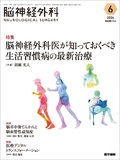Japanese
English
- 有料閲覧
- Abstract 文献概要
- 1ページ目 Look Inside
- 参考文献 Reference
Ⅰ はじめに
近年,脳神経外科治療,血栓溶解療法や脳血管内治療の飛躍的な発展により,脳卒中死亡率は劇的に改善してきている.一方,超高齢化社会,食生活の欧米化に伴い,脳卒中の罹患者は依然として多く,脳卒中生存者の後遺症,合併症の負担の軽減は重要な課題となっている1).脳卒中後てんかんは,後天的に発症するてんかんのなかで脳神経外科医が最も高頻度に遭遇するてんかんであり,脳卒中生存者の重要な合併症の1つである.近年の報告では,高齢者のてんかんの原因の約半数を占めるという報告もある2).また,血管性認知症(vascular dementia:VaD)も近年のアルツハイマー病(Alzheimer disease:AD)のアミロイドβ抗体療法と相まって,その病態の理解は脳神経領域では必須のものとなっている.
本稿では,脳卒中後てんかん,VaDそれぞれにおける必須の知識について解説する.
Epilepsy and cognitive impairment are major post-stroke complications. As society ages, the number of stroke survivors increases, leading to a greater interest in these complications. Post-stroke epilepsy accounts for approximately half of all epilepsy cases in older adults and is associated with physical disability and mortality, emphasizing the importance of controlling seizures. Research is progressing on diagnostic methods, primary prevention, and secondary prevention of post-stroke epilepsy. Vascular dementia and Alzheimer's disease are the two major types of dementia and can be prevented and treated by addressing vascular risk factors such as hypertension, dyslipidemia, and diabetes. Currently, there are no available treatments to reverse vascular dementia, and many challenges remain unresolved. This review discusses the information necessary for clinical practice, including diagnostic criteria, classification, risk factors, measurements, and appropriate treatments for post-stroke complications.

Copyright © 2024, Igaku-Shoin Ltd. All rights reserved.


